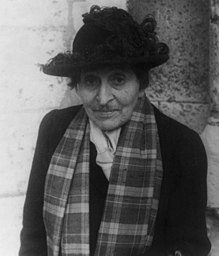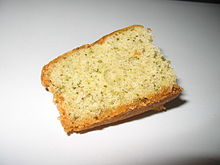Hemp preparation
A hemp preparation is a foodstuff mixed with hemp . In the English-speaking area such as are Edible (of English edible called "edible"). This term has also established itself as a jargon expression in German-speaking countries.
Most hemp preparations contain a considerable amount of THC , which when consumed can trigger the symptoms typical for the substance such as relaxation, euphoria, increased appetite, but also exhaustion and anxiety. Preparations in which THC dominates as an active ingredient are consumed as recreational drugs or for medicinal purposes . Some hemp preparations , especially those containing industrial hemp , contain only small amounts of THC and are instead mixed with other cannabinoids; most commonly cannabidiol (CBD).
history
The first known hemp preparation is Bhang , which is mostly used in India, among other things in Hindu religious rituals. The oil viscosity of hemp extracts was already known in ancient India . For example, it was common to fry hemp in ghee before mixing it with other ingredients .
Alice B. Toklas' cookbook The Alice B. Toklas Cookbook is considered to be the trigger for the modern interest in hemp-infused dishes . This contains a recipe for haschich fudge that was contributed by artist and friend Brion Gysin to the publication of the book in 1954. Although deleted from the first US editions of the book, Toklas' name and recipe became the guiding symbol for hemp and the counterculture of the 1960s.
In some US states that have legalized hemp, hemp preparations have seen a dramatic increase in sales. However, there is a growing concern about the dangers to children and inexperienced cannabis users. They could inadvertently ingest too large quantities of the preparations or not even know that the food contains hemp.
Effect on consumption
Since hemp does not naturally contain THC, but the precursor substance tetrahydrocannabinolic acid (THCA), cannabis has to be decarboxylated in order to convert THCA into THC. If this happens, a carboxyl group falls away. THC then breaks down to cannabinol while it is stored; THCA decarboxylates quickly, but not completely, when heated.
A comparison of the effects of consuming hemp preparations and smoking hemp products is difficult because results are often inaccurate due to the varying smoking behavior of consumers. When hemp preparations are ingested orally, fatty carrier substances in which cannabinoids are dissolved for oral intake influence the uptake of the cannabinoids. The metabolism of every person is also different. However, because oral doses are processed by the digestive system and liver before entering the bloodstream, cannabinoids ingested via the gastrointestinal tract are generally absorbed more slowly and have a delayed and lower peak concentration than when they are inhaled through smoking (peak = peak, peak value). Ingestion generally leads to two peak concentrations due to the enterohepatic circulation .
Oral consumption of THC leads to absorption by the liver and metabolic processes to convert a substantial portion of it to 11-hydroxy-THC, which is stronger than THC and more easily crossed the blood-brain barrier.
Types of preparation
Pastries
A hemp-containing pastry is a popular hemp preparation. Popular types are biscuits containing hemp or brownies or other cakes. Normally, one cannot distinguish between regular baked goods and those containing cannabinoids before consuming them. However, products containing hemp often have a light green complexion and give off a faint hemp odor. A mild weed or cannabis flavor can occur with sufficient quantities. Many sources for prescriptions, preparation and dosage are available online, but they vary greatly in effectiveness and quality.
beverages
Traditional cannabis drinks are the Indian drinks Lassi and Thandai when they are prepared with a bhang. Cannabis tea is a mildly psychoactive herbal tea, but is psychoactively weak due to the lack of fat and alcohol. In the US states that legalized recreational cannabis, the share of beverages in the cannabis market was around 4% in 2014, but fell to around 1.5% in 2016.
Oils
Hash oil is an oil-like extract that is mostly high in THC . Like hashish, it is obtained from the resin of the inflorescences, which come from the female hemp plant ( cannabis ). Hash oil is used both as a medicine and as an intoxicant .
See also
Individual evidence
- ^ National Institute on Drug Abuse: What are marijuana effects? Accessed August 8, 2018 .
- ^ Oregon's recreational marijuana market expands to edibles and extracts starting Thursday . In: OregonLive.com . ( oregonlive.com [accessed August 8, 2018]).
- ↑ 10 Little-Known Uses for Cannabidiol or CBD Oil • High Times. Retrieved August 8, 2018 (American English).
- ↑ The Bhang Lassi Is How Hindus Drink Themselves High for Shiva . In: Munchies . March 10, 2015 ( vice.com [accessed August 8, 2018]).
- ↑ a b Twentieth Century Alchemist .: The art and science of cooking with cannabis: the most effective methods of preparing food & drink with marijuana, hashish & hash oil . [3rd ed.]. Ronin Pub, Berkeley, Calif. 2009, ISBN 978-1-57951-092-3 .
- ↑ Layla Eplett: Go Ask Alice: The History of Toklas' Legendary Hashish Fudge . In: Scientific American Blog Network . ( scientificamerican.com [accessed August 8, 2018]).
- ^ Edible Marijuana Sales Continue to Rise, With Gummies and Mints Topping Sales . In: The Daily Meal . February 22, 2017 ( thedailymeal.com [accessed August 8, 2018]).
- ^ The rise of legal weed in America . November 26, 2016 ( theweek.com [accessed August 8, 2018]).
- ↑ Margie Skeer: Edible marijuana: What we need to know . In: The Conversation . ( theconversation.com [accessed August 8, 2018]).
- ↑ Decarboxylation of Tetrahydrocannabinolic acid (THCA) to active THC. In: European Industrial Hemp Association (EIHA). Retrieved August 8, 2018 .
- ↑ MA Huestis: Pharmacokinetics and metabolism of the plant cannabinoids, delta9-tetrahydrocannabinol, cannabidiol and cannabinol . In: Handbook of Experimental Pharmacology . No. 168 , 2005, ISSN 0171-2004 , p. 657-690 , PMID 16596792 .
- ↑ Debra Borchardt: Marijuana Drinks Not Causing a Buzz . In: Forbes . ( forbes.com [accessed August 8, 2018]).

